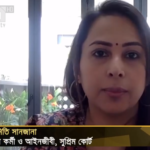
Chittagong Hill Tracts Peace Agreement
একুশের বিশেষ অনুষ্ঠান “পার্বত্য চট্টগ্রাম শান্তি চুক্তি” https://youtu.be/TFv4DLtmj2c Women and girls are victims of torture Women and girls are victims
Published by The Daily Star, May 28,2019 (link Here)
This week Your Advocate is Barrister Omar Khan Joy, Advocate, Supreme Court of Bangladesh. He is the head of the chambers of a renowned law firm, namely, ‘Legal Counsel’, which has expertise mainly in commercial law, corporate law, family law, employment and labor law, land law, banking law, constitutional law, criminal law, IPR and in conducting litigations before courts of different hierarchies. Our civil and criminal law experts from reputed law chambers will provide the legal summary advice. Barrister Omar Khan Joy
Query:
I study computer science and engineering in DUET. I am in the final year of my bachelors. Last semester of the final year, I designed a robot which can speak in four different languages (Bangla, English, French and Spanish) through automation. The unique feature of this robot is that it can predict human thinking during conversation. In an experiment, the result shows that in 65% cases, the automated feature works without any external help. Now, I am planning to protect the legal rights relating to my creation. Can you tell me about the legal procedure for the protection of my intellectual creation?
Jaman Tarafder, Dhaka
Response:
Dear Mr. Tarafder,
Thank you for your query. From the fact it appears that you have designed a robot and now you are looking to patent it. In general, the Intellectual Property (IP) is protected in law by patents, copyrights and trademarks, geographical indications, utility model, trade secret which allow people to earn recognition or absolute financial benefit from what they have invented or created. The IP system aims to adopt a creative and innovative environment and maintain a right balance between the interests of the innovators and the wider public interest.
Basically, an exclusive right of patent is usually granted for an invention under the Patents and Designs Act, 1911 read with Patents and Designs Rules, 1933. In order to be patentable, an invention should relate to a manner of manufacture which is novel and it should have a practical existence. In order to obtain the patent for your invention, you need to first file an application for a patent under the Section 3 of the Patent and Design Act 1911, and the application must be made to the Department of Patents, Designs and Trademarks (DPDT) in the prescribed form. To file the application, you will need the following information:
(a) Name of the inventor (applicant),
(b) Address(s) and nationality of the inventors,
(c) Two sets of specification and one set of drawing on tracing paper (transparent),
(d) One set Legalised Deed of Assignment (if any),
(e) Power of Attorney [Form – 31],
(f) Certified copy of the foreign patent (in case of claiming priority).
Additionally, the application must contain a declaration that you are in possession of an invention, claiming you are the true and first inventor or the legal representative or assignee of such inventor and for which you should obtain a patent, and must be accompanied by complete specification under Section 4 of the Act which states that an application must contain a complete specification or provisional specification. A provisional specification must describe the nature of the invention and a complete specification must particularly describe and ascertain the nature of the invention and the manner in which the same is to be performed. A specification, whether provisional or complete, must commence with the title, and in the case of a complete specification must end with a distinct statement, of the invention claimed. If you do not submit a complete specification with your application, then you must do so within nine months from the date of the application, as stated in Section 4A of the Act.
Further, the Registrar may require the suitable drawings/model or sample illustrating the invention as part of the complete specification. And on the acceptance of an application, the Registrar will give you a notice and will advertise the acceptance along with the drawings (if any) required for public inspection. If there is no opposition you will be granted a patent, subject to such conditions as the authority thinks expedient.
Ultimately, the term limit in every patent is sixteen years from its date and renewal is required after four years up to 15 years. In case of priority, the commencement of four years will start from the date of priority application.
One thing I would like you to bear in mind is the concept of patenting Artificial Intelligence (AI) has been very controversial through the past years across the world. Many countries like India, U.S and New Zealand, are reluctant to provide patent for software due to the complex requirements of such patent process and the costs for obtaining and enforcing a patent may be expensive unless you have important financial resources. Apart from patent, there are other types of intellectual property, such as trademarks, industrial designs and trade secret protection that might be a better option in securing your invention.
But there are definitely some provisions you can look into if you are determined to patent your invention, specifically through The Agreement on Trade-Related Aspects of Intellectual Property Rights (TRIPS). Furthermore, I would advise you to contact DPDT before formally filing the application.
I hope that my aforementioned opinion will help you to take appropriate steps, in order to protect the legal right for your invention.
Intellectual Property (IP), patents, copyrights, trademarks, Patents and Designs Act, 1911, laws on IP

একুশের বিশেষ অনুষ্ঠান “পার্বত্য চট্টগ্রাম শান্তি চুক্তি” https://youtu.be/TFv4DLtmj2c Women and girls are victims of torture Women and girls are victims

দীপ্ত টিভির বিশেষ টকশো ‘শান্তি চুক্তির ২৬ বছর: অর্জন ও বাস্তবতা’ https://youtu.be/0sfUHph0_e4 Women and girls are victims of torture Women

দীপ্ত টিভির বিশেষ টকশো ‘শান্তি চুক্তির ২৬ বছর: অর্জন ও বাস্তবতা’ https://youtu.be/uq_j3mSW7Fo Women and girls are victims of torture Women

বাণিজ্যে নিষেধাজ্ঞা দেয়ার কিছু নেই: বাণিজ্য সচিব https://youtu.be/nfPDs63Aug0 Women and girls are victims of torture Women and girls are victims

১০ মাসে দুই হাজার ৫৭৫ নারী ও কন্যাশিশু নির্যা’ত’নের শিকার | https://youtu.be/XFzsz1zE7-s Women and girls are victims of torture Women
Drop Your Queries

Dhaka Office
Chattogram Office
Dhaka Office Map
Chattogram Office Map